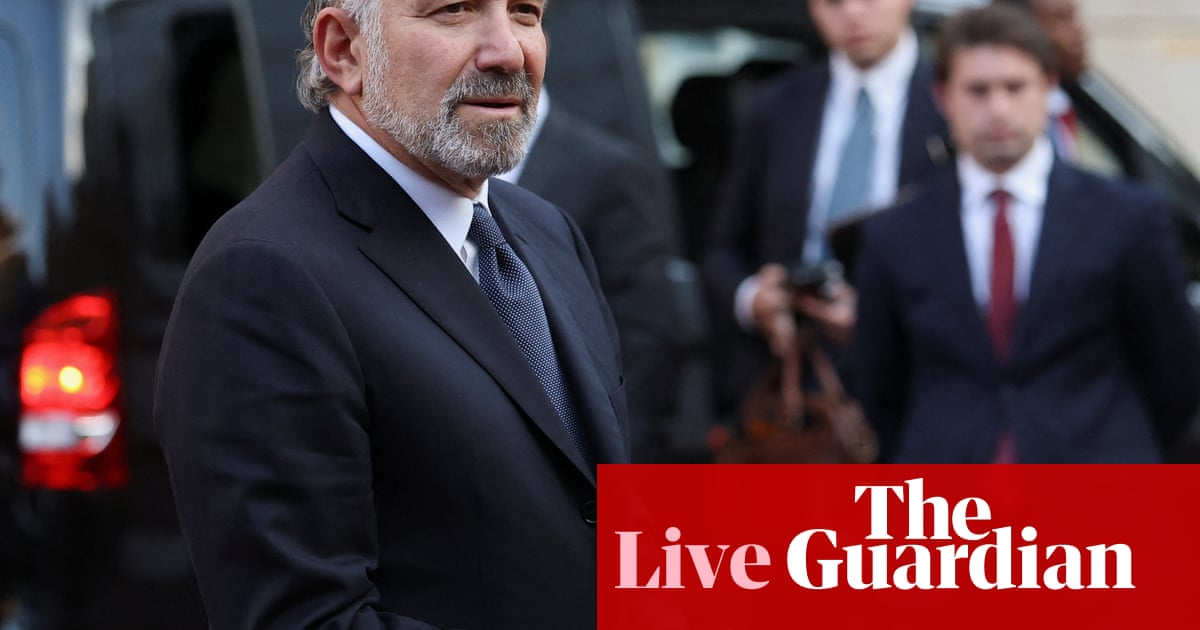Good morning, and welcome to our rolling coverage of business, the financial markets and the world economy.
“Jaw, jaw is better than war, war,”as Harold Macmillan once remarked. And after two days of talking in London, the US and China have managed to patch up their trade conflict truce.
Just before midnight last night the two countries agreed a framework that, it is hoped, will ease tensions between the two economic superpowers. It will reinforce their initial agreement made in Geneva a month ago, once presidents Donald Trump and Xi Jinping have approved it.
Speaking at Lancaster House last night, US commerce scretaryHowardLutnicksaid the trade framework and implementation plan agreed with China in London should result in restrictions on rare earths and magents being resolved.
That had been a key demand for the US side, worried that American companies were being starved of vital supplies.
Lutnick told reporters the US negotiating team will take the framework back to Trump to get his approval, and then hope to implement it.
China’s vice commerce ministerLiChenggangdescribed the talks as “rational and candid”, telling reporters:
The talks, which began on Monday morning, took longer than expected – with the two sides sustained by deliveries from restaurant chainOttolenghi, McDonald’s,BurgerKingandKFC.
Investors are now waiting for details of the agreement, and confirmation that it will satisfy Xi and Trump.
Traders are also anticipating the latest US inflation report, which may show that the trade war has driven up prices in the shops. Economists predict the US CPI index will have risen to 2.5%, from 2.3%.
While in London, chancellor Rachel Reeves will deliver the government’s spending review, outlining day-to-day departmental spending for the next three years.
12pm BST: US weekly mortgage applications data
12.30pm BST: Chancellor Rachel Reeves to deliver UK spending review
1.30pm BST: US inflation report for May
Josh Lipsky, senior director of theAtlanticCouncil’sGeoEconomicsCenterin Washington, fears that the US and China are still a long way from a wide-ranging trade deal.
Lipskyposted on X:
The US and Mexico may be close to a breakthrough in negotiations over steel tariffs.
Reuters are reporting that the two countries are negotiating a deal to reduce or eliminate President Donald Trump’s 50% steel tariffs.
An industry source familiar with the talks said that a likely outcome would include a quota arrangement, under which a specified volume from Mexico could enter duty free or at a reduced rate and any imports above that level would be charged the full 50% tariff.
Reuters add that it’s unclear whether the deal would eliminate tariffs altogether for in-quota steel import volumes from Mexico or reduce them to a lower level, and that the specific volume level of the quota also was not yet determined.
Reaction to the US-China agreement is flooding in this morning, as analysts digest the overnight news that a ‘framework’ has been agreed.
JimReid, strategist atDeutscheBank, says there is “perhaps a little disappointment” that we don’t have more details of the agreement, telling clients:
Chris Weston, head of research at brokeragePepperstone, agrees that “the devil will be in the details”, adding:
Lin Gengwei, CEO ofRainTreePartnersin Singapore, called the agreement a “temporary achievement”, adding:
Zeng Wenkai, chief investment officer atShengqiAssetManagementin Hong Kong, suggests more countries should stand up to the US in trade discussions:
Tony Sycamore, market analyst atIG, says the US and China have found a way to quell trade tensions which risked spiralling out of control last week.
Good morning, and welcome to our rolling coverage of business, the financial markets and the world economy.
“Jaw, jaw is better than war, war,”as Harold Macmillan once remarked. And after two days of talking in London, the US and China have managed to patch up their trade conflict truce.
Just before midnight last night the two countries agreed a framework that, it is hoped, will ease tensions between the two economic superpowers. It will reinforce their initial agreement made in Geneva a month ago, once presidents Donald Trump and Xi Jinping have approved it.
Speaking at Lancaster House last night, US commerce scretaryHowardLutnicksaid the trade framework and implementation plan agreed with China in London should result in restrictions on rare earths and magents being resolved.
That had been a key demand for the US side, worried that American companies were being starved of vital supplies.
Lutnick told reporters the US negotiating team will take the framework back to Trump to get his approval, and then hope to implement it.
China’s vice commerce ministerLiChenggangdescribed the talks as “rational and candid”, telling reporters:
The talks, which began on Monday morning, took longer than expected – with the two sides sustained by deliveries from restaurant chainOttolenghi, McDonald’s,BurgerKingandKFC.
Investors are now waiting for details of the agreement, and confirmation that it will satisfy Xi and Trump.
Traders are also anticipating the latest US inflation report, which may show that the trade war has driven up prices in the shops. Economists predict the US CPI index will have risen to 2.5%, from 2.3%.
While in London, chancellor Rachel Reeves will deliver the government’s spending review, outlining day-to-day departmental spending for the next three years.
12pm BST: US weekly mortgage applications data
12.30pm BST: Chancellor Rachel Reeves to deliver UK spending review
1.30pm BST: US inflation report for May
